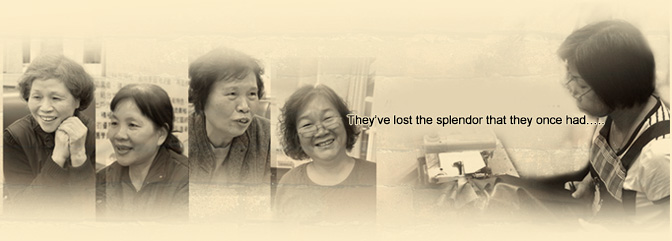Sewing Workshops
Present
From this interview, we learned that the garment industry was not only prosperous in the 1960s, but also made ludicrous profits. The employees could earn a high income through diligent work. As Ms. Bao-luan Chang recalled, many women employees in our factory earned more than their husbands working outside the home. The industry was incomparably prosperous at that time, and created the economic miracles of Taiwan. However, the garment industry faces fierce competitive pressure; the dumping of inexpensive garments from abroad has forced the garment manufacturers to win by production output.
We know from the interview that the transformation faced by the garment industry now is due to the work patterns. Most people in this line engaged in cloth design, pattern making and design, while working in relevant industries, or engaged in field sales and other service industries. On the contrary, the labor-intensive garment industry dropped remarkably or even had an age gap.
Ms. Chang pointed that the youngest employee of the factory is 50, and the oldest is 70. Many employees changed work after job loss or retirement without any other work opportunities. Besides, there were also many unregistered employees, who worked at home, for instance, old people or those unable to move freely. There were also groups that lived far away, who received materials through logistics and worked at home. They were paid by pieces of work completed. Those who went to work in the factory were locals. Although the working atmosphere was harmonious and happy, the concern of the proprietress could be seen by us that “when this generation of employees retires, the factory is probably going to shut down”.
In fact, the above illustrates the difficulty faced by garment factories today. Although textile and garment industry made Taiwan into one of the “Four Tigers” in Asia in the past, large factories relocated to overseas to lower the cost due to the shift of industrial economy and the international competition. This has reduced the employment in Taiwan. Many talents were lost as a result. As the development scale gradually reduced, the small and medium-sized factories failed to survive, and faced the outcome of shutting down. Therefore, the textile industry was once listed as “twilight industry”. Many young students avoided textile related majors in college due to the salutation of twilight industry. As a result, relevant majors had to be changed or even disappeared, and the special courses of textile became less. Taiwan Textile Federation contacted relevant departments to promote industry-academia cooperation, with the aim that the junior or the senior students could directly receive credits when interning in the factory, and the factory could provide wages after their skills were adept enough. In this way, they could work for the factories without any interruption after graduation, so as to keep excellent talents of Taiwan. |
